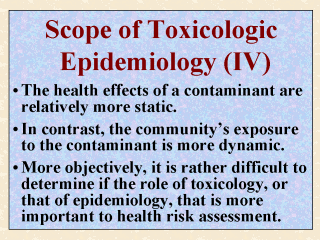| front |1 |2 |3 |4 |5 |6 |7 |8 |9 |10 |11 |12 |13 |14 |15 |16 |17 |18 |19 |20 |21 |review |
 |
With all due
respect, it is important to note that the health effects of a contaminant are relatively
more static, whereas the exposure of a community to that same chemical is more dynamic.
That is, once confirmed, the contaminant's health effects are permanent information. Yet
the community's acute or long-term exposure to this contaminant in the future can be
highly unpredictable, as it depends on many factors, such as variable population and
occupational mobility or otherwise the future access to the contaminant. It is based on the above argument that health risk assessment (RA) is considered to be more a part of epidemiology than of toxicology, and hence more appropriately disguised as toxicologic epidemiology than as regulatory or epidemiologic toxicology. To some extent, this series' biased perspective echoes that of the book Environmental Epidemiology and Risk Assessment (Aldrich et al., 1997), which offers a new conception of the methodological considerations involved in the conduct of environmental epidemiology studies. That volume includes a fair amount of discussion on the basic principles of risk assessment and risk communication. The relevance of epidemiology in RA is also discussed extensively in another collection of 17 papers entitled The Role of Epidemiology in Regulatory Risk Assessment (Graham, 1995). More objectively, however, the question whether RA is more the role of toxicology or of epidemiology is analogous to the question which American people nowadays avoid to answer: Is the wife's role, or the husband's, that is more important to a family? |